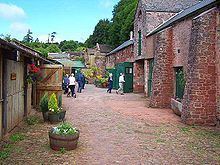Population 10,636 (ward2011) Unitary authority Local time Wednesday 6:14 AM | OS grid reference SX8963 Sovereign state United Kingdom Dialling code 01803 | |
 | ||
Weather 11°C, Wind SW at 24 km/h, 93% Humidity | ||
Cockington village watermeadows and country park
Cockington is a village in Torquay in the English county of Devon. It is a picturesque village, with old cottages within its boundaries. It is about a half a mile away from Torquay.
Contents
- Cockington village watermeadows and country park
- Map of Cockington Paignton UK
- Cockington village torquay devon
- History
- Buildings
- Cricket Pavilion and grounds
- Drum Inn
- The Almshouses
- Cockington Court
- Other notable buildings
- Notable residents
- References
Map of Cockington, Paignton, UK
Cockington village torquay devon
History
The village was probably founded 2,500 years ago during the Iron Age with evidence of two hill forts on either side of Cockington valley. Little is known about Cockington from that point up until the remains of a small Saxon village were found near the Drum Inn. The evidence from this village shows that it was primarily a fishing and farming village. The first official documentation of the village was in the 10th century. The manor was owned by Alric the Saxon, before William Hostiarus, William de Falesia and Robert FitzMartin, who passed it down to his son Roger, who renounced his name to become Roger de Cockington. The Cockington family owned Cockington Estate from 1048–1348. The Cary family owned the court from 1375 to 1654. It was then sold to the Mallock family a family of rich silversmiths from Exeter, who owned it from 1654 to 1932 when they sold the estate to the Torquay Corporation.
Buildings
There are several buildings of note in Cockington.
Cricket Pavilion and grounds
The park which is now home to the cricket grounds was originally a medieval deer park. Cricket started to be played on it in 1947. The current cricket pavilion was built after the original burnt down ten years ago.
Drum Inn
The Drum Inn is the local pub/restaurant in Cockington. Designed by Edwin Lutyens, it opened in 1936 to replace the old ale-house.
The Almshouses
The Almshouses consist of seven terraced cottages built during the reign of King James I of England by the Cary family to house the poor and those who could not work within the village. When the Mallock family took over the Cockington estate, the almshouses fell into disrepair. They were rebuilt between 1790 and 1810.
Cockington Court
The Court was the mansion house of the Mallock family, and remains the focal point of the estate. Originally built in the 16th century, it has few architectural features remaining from then, but was altered and extended several times, particularly in 1673 by Rawlyn Mallock and about 1820 by the Rev'd Roger Mallock. He had the top floor removed and the interior remodelled. Its historical significance merits great care in maintaining its existing fabric and in ensuring new elements are sympathetically designed.
Cockington Court was built over the remains of a medieval court. A far cry from the days of the Cary family when it was an actual court, it is now filled with various arts and crafts workshops.
In her youth, Agatha Christie regularly visited Cockington. Her novel Why Didn't They Ask Evans? is dedicated to Christopher Mallock. The Mallock family were friends of Christie's from the years before her first marriage. The Mallocks staged amateur theatricals at Cockington Court, in which Christie, managing to overcome her usual crippling shyness, took part.
Other notable buildings
Notable residents
Chronologer Robert Cary was born in Cockington in about 1615. Robert Sweet (1782-1835), horticulturalist and author, was also born in the village.
